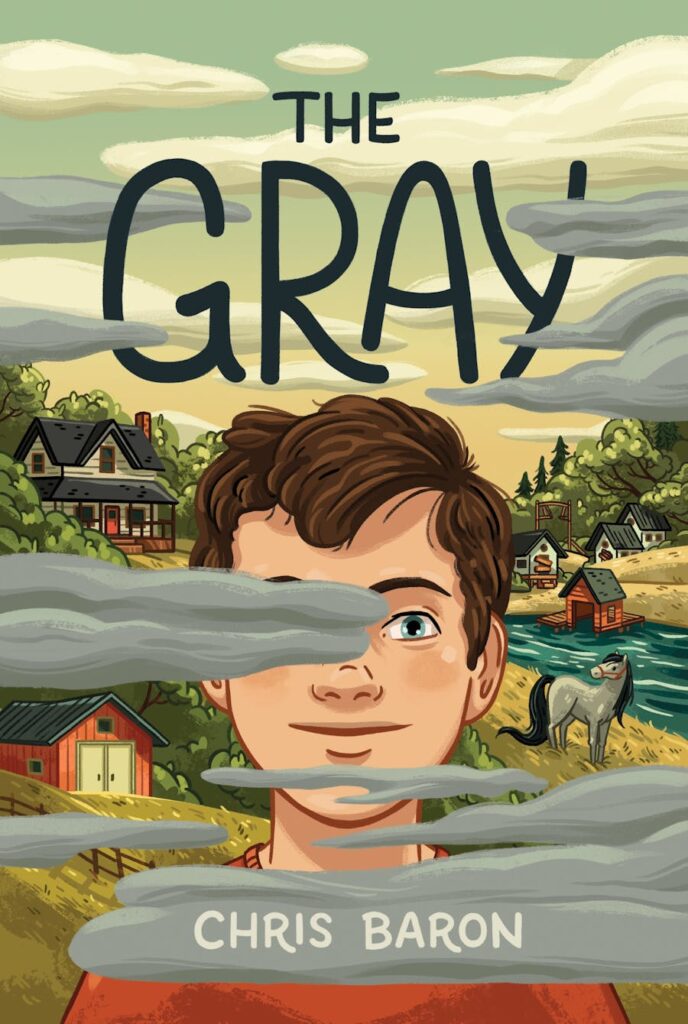In Chris Baron’s newest middle-grade novel, THE GRAY (Feiwel & Friends/Macmillan, 2023) Sasha is struggling with anxiety which he calls “the gray.” When his parents suggest he spend time with his aunt in the country, Sasha has the opportunity to find unexpected friendships, including a connection with a horse that helps him gain a deeper understanding of himself and the world around him. THE GRAY is filled with hope, heart, and a bit of Jewish mysticism. I am so happy to learn more about this wonderful novel. Welcome back, Chris.
Sasha struggles with anxiety (the Gray) and the life and relationship complications that often come with it. He also learns to cope using some traditional and unique methods. What do you hope your readers take away from Sasha’s journey?
Like in any story I write–I hope that kids engage with the adventure of the story, the beauty of the landscape, and the sense that they are not alone! I want readers to relate with the complexities and complications that come with relationships. And of course, I hope readers take away authentic and practical strategies that can help them cope with everyday challenges. According to the American Psychological Association, “20.5% of youth worldwide now struggle with anxiety symptoms.” Too often-kids who experience anxiety of any kind are not diagnosed or even helped. Kids don’t always know what to do. From pandemic stress, reliance on technology and information overload, to everyday family struggles, lots of kids and their families are facing stressors they never have before. I know as a dad, I do all I can to help my kids, but there are times where we need additional, sometimes professional, help and help is good. My sincere hope is that through Sasha’s journey, kids will not only feel seen and heard, but will know that it is okay to need help. I want readers to discover the many practical tools they can use to overcome anxiety in their own lives, and feel supported so they know they are not alone!
Also, I want kids to take away a sense of wonder, adventure, and a little bit of the supernatural world that flows through the landscape of the story –an escape from the city –to an abandoned-camp-horses-ghosts?-and the chance to do things they never thought they were capable of. And of course, and this is something I find myself writing about in all my books, the importance of family. Finally–and maybe most importantly? Horses. There is a deep love for all the horse characters in the book. They are incredible animals, and there is something so powerful about connecting with another creature larger than we are and developing trust. I hope they are encouraged to get out and maybe even ride horses–or do something that inspires them!

Sometimes Sasha rises to a challenge and sometimes he is unable to do so. Readers feel Sasha’s emotions when things don’t go as planned. Tell me a bit about the importance of being honest with readers about failure and disappointment.
I love this question, and I feel strongly about being honest in writing as part of the experience for characters and for readers. When I read a story, I am drawn to a character’s voice–I want that voice to feel authentic. I think we are often the most authentic version of ourselves when we come through failure and disappointment. We all face challenges of the mind, body, and spirit, and as adults we spend a lot of time practicing how we might articulate these challenges, but I think young people experience challenges in such an emotionally tender and unhindered way.
I wanted to capture that in The Gray, and for Sasha to demonstrate real failing, but also powerful growth and resilience – and eventually success in the most unexpected places. I know that there are many people who think of kids (and adults) who suffer from any sort of mental health issue as “suffering,” and often see weakness. I don’t think this is on purpose–it’s just a perspective that’s out there. But the truth is -like so many folks-Sasha is incredibly resilient and able to work through some of the incredible challenges that come his way (or that he wanders into) and come out the other side more himself than ever.
Too often, kids who experience anxiety are not diagnosed or even helped. Kids don’t always know what to do. What I love about books is how they tell the whole story of growth and change for characters. With Sasha, kids will see the journey he goes on, the challenges he faces, and how he makes it through all of them.
You have a lot of intertwined storylines in THE GRAY – including Sasha, his friends and family, the unique setting of an abandoned Jewish camp, and a bit of spirituality. As a writer, how did you keep track of all these threads and their connection to Sasha?
One day I will have the courage to share photos of my messy office so you can see the clothes pins holding the pages of notes, journals with maps and drawings of random locations, different colored ink-splashed pages of ideas spilling everywhere into the house. When this is happening, I know I am living in the story, and storylines are intertwining, crossing over, webbing me into them. I have to crawl my way out. But I think this is true for all of us. We live lives of many threads going in every direction all the time.
For The Gray, the most challenging part really was to keep track of timeline, flashbacks, memories, and of course all the echoing supernatural goings on of The Gray. But what helped me the most is that this story, like almost all of the ones I write, is so deeply connected to my own experience. When I was in second grade, we moved from New York City to a horse farm upstate. I went from being a city kid to suddenly living in the middle of a forest. I learned to ride horses, love nature, and made new friends with extremely different interests. And at that time, I was dealing with my own anxiety. The author’s note in The Gray speaks quite a bit about my experience with anxiety. This close connection with the experiences, even as this is a work of fiction, helps me to SEE the story as I write it, and that visual and experiential imagery helps me to keep track of all the threads.
Rabbi Akiva’s teachings play an important role in the story. Why do these teachings feel relevant for Sasha and the challenges he faces?
Sasha needs change. But how? The story of Rabbi Akiva and the Stone is well known. The idea that, as it reads in The Gray, “Even the smallest drop of water can change the largest stone.” Maybe this means the same thing for Sasha as it did for Rabbi Akiva–that if this kind of slow change is possible-tiny drops of water changing an impossible stone–that maybe there is hope for him too? He can persevere, be resilient, and that it’s never too late. Even though we can’t always see it, the change is still happening.
This is such an important part of the story-the intergenerational relationships speak to the resilience and the value of spiritual, cultural and familial teachings, as a way of facing the many challenges of life.
I think Sasha’s Jewish heritage is very close to mine. The faith, the culture, and even the more mystical parts were all something I experienced with my family. For all of the Jewish Holidays, big and small, I grew up hearing stories that helped me understand my heritage, my faith, my culture, and how I might fit into this giant world we live in. Those stories are relevant today, and I share them with my own children now. It’s fun to see them start to make these same connections as they grow.
Also-I just have to share that, as I mentioned, when we moved up state from the city to the country, I spent a lot of time exploring the forest-which I absolutely believed (and still do) was enchanted. Just like in the story, there was a pond, and that pond had a giant stone in it. We called it the meteorite because it was huge-like it had no place being there. In the story, when I write of the stone of power in The Gray, it actually exists!

Your previous novels have been in verse. How was the process of writing a prose novel different?
Since poetry feels more like my native language, I wrote much of The Gray in verse during the writing process. Of course, there is a lot of prose that is poetic and lyrical, and I am hoping that’s true in places for The Gray, but eventually the verse chapters became prosaic, and as I explored the story, it was clear that this truly is a novel meant for prose. The way chapters unfolded I found the story demanded more detail and exploration of setting, of time, and of action. So, I like to say that while The Gray is prose, the spirit of the book is verse.
Thank you, Chris!
Chris Baron is the award winning author of Novels for young (and young at heart) readers including All Of Me an NCTE Notable Book, The Magical Imperfect a Sydney Taylor Book Award Notable Book/ a SLJ Best Book of 2021 & the forthcoming novels, The Gray (23) Forest Heart (24) from Feiwel & Friends/Macmillan, and The Secret of the Dragon Gems, a Middle Grade novel co-authored with Rajani LaRocca from Little Bee Books (23) and editor of ON ALL OTHER NIGHTS: A MIDDLE GRADE PASSOVER ANTHOLOGY, from Abrams (24), He is a Professor of English at San Diego City College and the director of the Writing Center. He grew up in New York City, but he completed his MFA in Poetry in 1998 at SDSU. He lives in San Diego with his family.